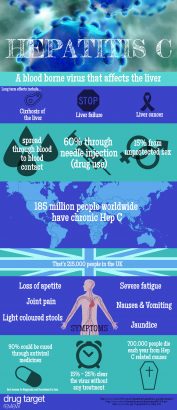H is for Hepatitis C
Posted: 23 November 2016 | | No comments yet
H is for Hepatitis C – the next instalment of our daily pharmaceutical alphabet bringing you up to date with all the latest in Hep C research…


With just over a month left until the end of year, we decided to bring together the biggest and best pharmaceutical news from over the last 12 months to make sure you’re up to date when it comes to our ever growing industry. An opportunity to look at how far we’ve come in our fight against the world’s deadliest and most widespread diseases, and how very far we still have to go in finding new drug targets and treatments against many more. From Antibiotics to Zika, drug discovery to regulatory approval, new treatments, better medicines, healthcare cuts and novel approaches – all to find solutions to the many unmet calls for aid seen around the globe, let European Pharmaceutical Review put you in the know.

H is for Hepatitis C
To find out more about Hepititis C, European Pharmaceutical Review spoke with Raquel Peck, CEO of the World Hepatitis Alliance and discovered exactly what is being done to combat this widespread global health issue.
In July of this year, AbbVie announced that the U.S. Food and Drug Administration (FDA) approved Viekira XR (dasabuvir, ombitasvir, paritaprevir and ritonavir) for the treatment of patients with chronic genotype 1 (GT1) hepatitis C virus (HCV) infection, including those with compensated cirrhosis
September brought the news that the US Food and Drug Administration (FDA) has granted breakthrough therapy designation (BTD) for AbbVie‘s investigational, pan-genotypic regimen of glecaprevir (ABT-493)/pibrentasvir (ABT-530) (G/P) for the treatment of patients with chronic hepatitis C virus (HCV) who failed previous therapy with direct-acting antivirals (DAAs) in genotype 1 (GT1), including therapy with an NS5A inhibitor and/or protease inhibitor.


AbbVie’s new data from their Phase 3b garnet trial shows that 98% (n=160/163) of previously untreated patients with genotype 1b (GT1b) chronic hepatitis C virus (HCV) infection without cirrhosis achieved sustained virologic response rates at 12 weeks post-treatment (SVR12) following eight weeks of viekirax (ombitasvir/paritaprevir/ritonavir tablets) plus exviera (dasabuvir tablets) treatment.


Then, later in November, AbbVie announced high SVR12 rates with 8 weeks of treatment with its investigational, pan-genotypic regimen of glecaprevir (ABT-493)/pibrentasvir (ABT-530) (G/P) across all major chronic hepatitis C virus (HCV) genotypes.


The US Food and Drug Administration (FDA) has granted approval for Roche‘s cobas MPX test for use on the cobas 6800 and 8800 Systems. The cobas MPX assay enables donor screening laboratories to apply the most advanced PCR-based diagnostic technology to the surveillance of donated blood and plasma in the US, preventing the spread of Human Immunodeficiency Virus Groups 1 and 2 (HIV-1 and HIV-2), Hepatitis B Virus (HBV), and Hepatitis C Virus (HCV) through transfused blood products.
Finally, following successful phase 3 clinical trials, in which MSD’s new Hepatitis C drug, Zepatier, performed well, achieving high virologic cure rates across the study, the European Commission has licensed the drug for sale in the European market, specifically for the treatment of chronic hepatitis C virus (HCV) in adults with genotype 1 and 4 infection.
Check back tomorrow for the next letter in our pharma alphabet!
What do you think? We’d love to hear from you so drop us a comment below and tell us your thoughts.
CALL FOR WRITERS
Is this your specialist subject? Are you a scientist, student or do you work in the pharmaceutical industry? If you’d like contribute an article to the website and/or become one of our expert writers, please do get in touch with Niamh Marriott





